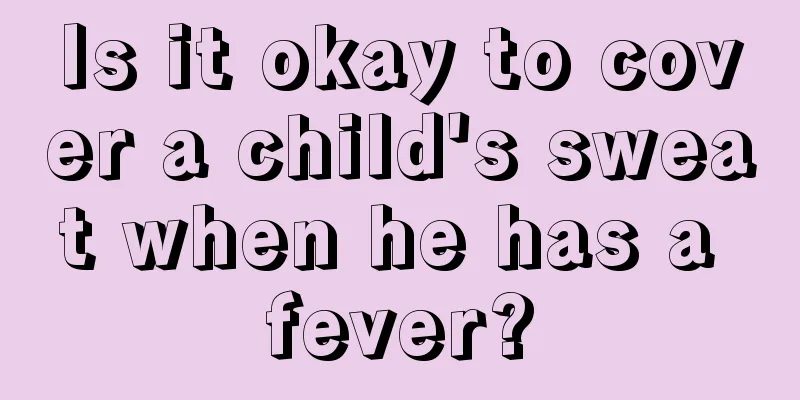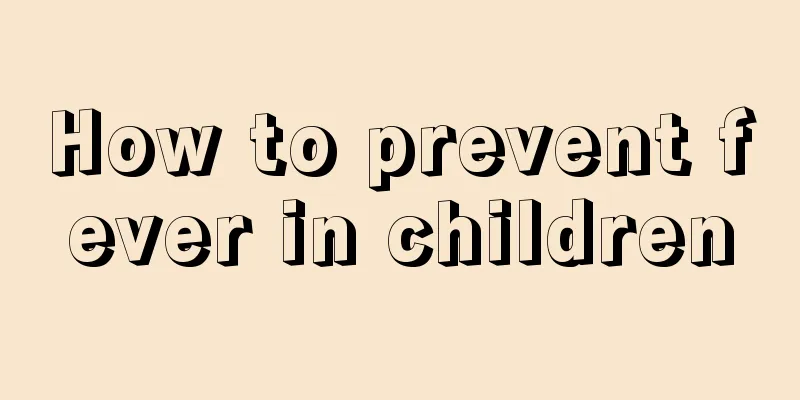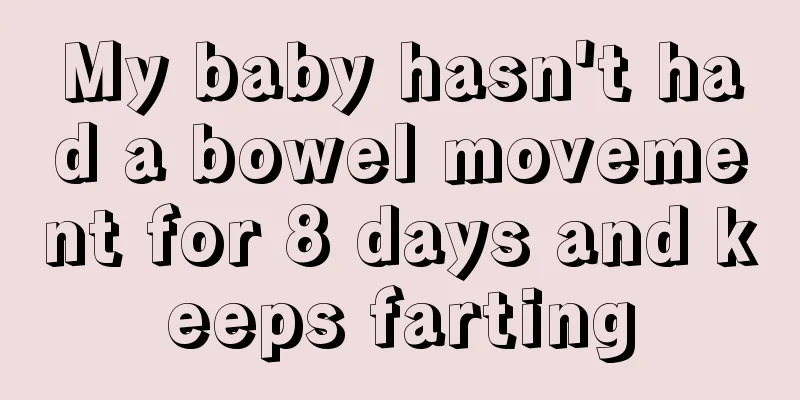Is it okay to cover a child's sweat when he has a fever?

|
Covering up children's sweat when they have a fever is a common method used by many older generations, especially when the children are left in the care of their grandparents. As long as the children have a fever, they will use this method to promote sweating in the children, trying to use this method to expel the cold in the children's bodies. However, is this method really feasible? Now let us understand whether this method of covering up children's sweat when they have a fever is advisable under modern medicine. 1. Is it good to cover up sweat when a child has a fever? Many elderly people believe that babies should be covered to sweat after having a fever, so that the disease can be cured quickly. In fact, the baby's body temperature regulation center is imperfect. The "sweating" method not only fails to lower the body temperature, but will cause the body temperature to rise suddenly and cause high fever convulsions. The correct approach is: when the baby has a fever, you should wear less clothes and cover less to increase heat dissipation. If your body temperature exceeds 38°C, you can use a towel to take a warm water bath, so that when the water evaporates, it can take away a lot of heat. You can use ice packs to cool your head to relieve headache symptoms and protect brain cells. If the fever persists, go to the hospital immediately. 2. Parents are prone to the misunderstanding of covering up sweat As soon as the baby has a fever, parents will cover the baby tightly, dressing him in "three layers inside and three layers outside", making him look like a steamed dumpling. Some mothers say that their children are very afraid of cold when they have a fever. Some say that wearing thicker clothes is to cover up sweat, and the child’s fever will go away once he sweats. Children's sweat glands are underdeveloped, so it is not easy to achieve the purpose of "sweating" by "covering up the sweat". For children, the more they are covered, the higher their body temperature will be, which can easily cause "heat syndrome" (that is, children will have a series of symptoms such as high fever, pale complexion, slow reaction, and difficulty breathing due to covering too tightly) and can also easily induce high fever convulsions. Dr. Li Dongfang said that when children have a high fever, their limb circulation often deteriorates, and their hands and feet do not feel hot but rather cool. If the baby has cold hands and feet, is afraid of wind, and likes to snuggle in his mother's arms, he may soon develop a fever. Therefore, parents should not assume that their children’s hands and feet are cold because they are not dressed enough. When a child has a fever, the correct approach is to slightly unbutton the child's clothes to allow the child to fully dissipate the heat and keep the child's hands and feet warm. Many elderly people believe that babies should not be bathed when they have a fever, as bathing can easily cause them to catch a cold. In fact, taking a hot bath is more conducive to heat dissipation for children with fever. If taking a bath is inconvenient, a warm bath is also a very effective physical cooling method to reduce fever. 3. If you have a low-grade fever and are eager to take antipyretics A newborn baby, who was only a dozen days old, caught a cold and had a fever of 38 degrees Celsius. The parents were extremely anxious and immediately asked the doctor to prescribe antipyretics after arriving at the hospital. They thought that if the child did not take the antipyretics, the continued fever would damage his brain. Newborns (less than 28 days old) should not use antipyretics. In fact, under normal circumstances, antipyretics can only be used for children over 6 months old. Because newborns are weak and have a large body surface area, it is difficult to control the dosage of antipyretics, and they are prone to collapse or gastrointestinal damage. Experts believe that, under normal circumstances, antipyretics should only be used when the body temperature reaches 38.5 degrees Celsius or above, and should not be used for low fevers. For babies under 6 months old, physical cooling methods are usually used, such as warm water baths, fever-reducing patches, hot baths, etc. However, if a child has had a febrile convulsion before and has a fever again, he or she should actively reduce the fever. Under the guidance of a doctor, he or she can take antipyretics when the body temperature reaches 38 degrees Celsius or earlier in order to reduce the temperature as soon as possible to avoid another febrile convulsion. 4. Nursing for cold and fever Recently, there was a post on the Internet saying that applying Chinese medicine to the soles of the feet can reduce high fever. The reporter took a closer look and found that it was made by grinding almonds, peach kernels, gardenia kernels, and jujube kernels into powder, then mixing it with duck egg white into a thin paste, putting it on clean gauze or other clean cloth, and applying the medicine to the soles of the baby's feet. The post also said seriously: "Boys should apply the left foot and girls should apply the right foot. 1-2 times can control high fever, and there will be no rebound and no toxic side effects." This post was welcomed by many mothers, and they posted comments saying that they would try it on their babies. As for reducing children's high fever, there are many safe and effective antipyretic drugs in the hospital. When it comes to children's medication, safety always comes first. Therefore, experts believe that parents should not blindly believe in "folk remedies" or "secret recipes" to solve children's high fever. As for "boys apply the left foot and girls apply the right foot", there is no clinical research to confirm this. Children's skin is thin and tender, with abundant subcutaneous blood vessels. When they have a fever, physical cooling methods such as warm water baths and external application of fever patches can be used, especially for infants and young children. These methods have fewer side effects and are better than drug cooling methods. In addition, a warm water bath is also a good choice. When doing a warm water bath, the water temperature should be 35-40℃. Rub the skin all over the body. Pay attention to applying force evenly during the bath. You can also use massage techniques to stimulate passive expansion of blood vessels and promote heat dissipation. Rub on the head, neck, armpits, chest, groin and other areas with rich blood vessels and stay there for a little longer to help dissipate heat. Bathe the limbs and back for 3-5 minutes each. When taking a sponge bath, you should be careful to avoid being exposed to the wind and getting cold. After the bath, wrap the baby with a large towel and give the baby more warm water. After reading the above article about covering up sweat when a baby has a fever, I believe parents have already understood that blindly covering up sweat is not conducive to the baby's recovery and may even have a counterproductive effect. When the baby's temperature is too high, mothers can wrap ice cubes in a handkerchief and slowly wipe the baby's body, and then take the baby to the hospital for examination and treatment in time. In addition, remember not to give the baby antipyretic drugs casually. It is best to treat under the guidance of a doctor. |
<<: How to treat a five-year-old child with a fever
>>: How to treat sneezing and fever in children
Recommend
What to do if your baby has a cold and refuses to drink water
The frequency with which a person catches a cold ...
It is normal for babies to poop every few days
Babies do not have good expressive abilities, and...
How to treat pulmonary artery stenosis in infants?
Many babies get sick as soon as they are born, wh...
What to do if a 1.5-year-old baby has a high fever and convulsions
Many babies will get sick, which is not only rela...
What is the reason for high lymphocyte count in children's blood routine test?
Routine blood tests for children can detect many ...
What should children eat to strengthen their spleen and stomach?
Nowadays, more and more of us are under great pre...
Emergency treatment for a child's dislocated elbow
Many babies are lively by nature, love to play an...
What to do if your child has a mild runny nose
Runny nose is a very common phenomenon in childre...
What should I do if a girl has bad breath?
As girls grow older, they will pay more and more ...
Treatment of enlarged adenoids in the nose in children
Enlarged adenoids in children's nose is a rel...
What should I do if my nine-year-old child can’t sleep at night?
Sleeping is the most important part of helping ch...
Port wine stain on baby's head
Every child is a lovely little angel, born with t...
What are the developmental indicators of a 13-month-old baby?
The baby is 13 months old. Parents of these child...
Children often shake their heads
Children often change their postures when they sl...
The child has a bone protrusion in the cervical spine
If parents find that their child has a bone protr...









